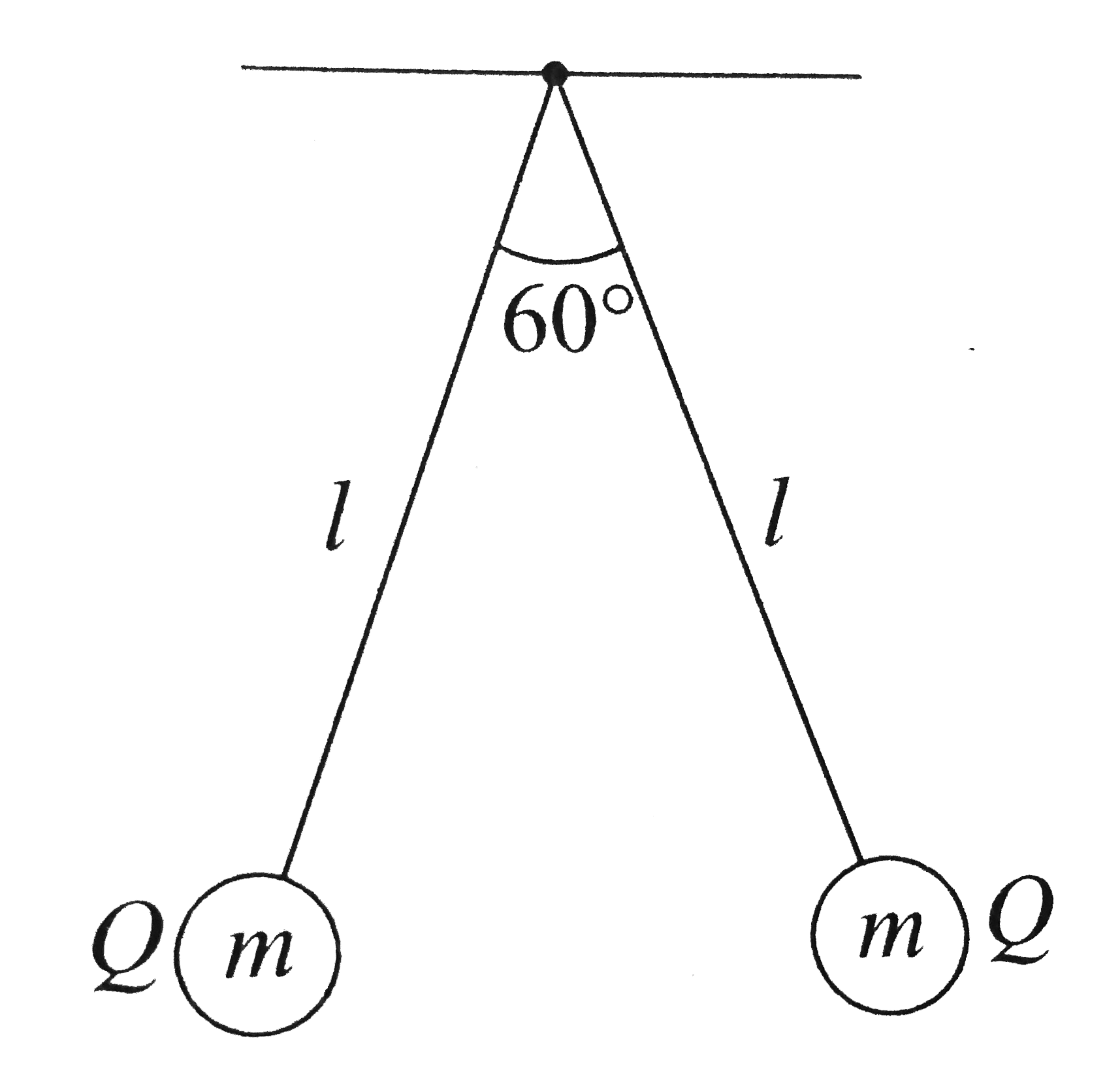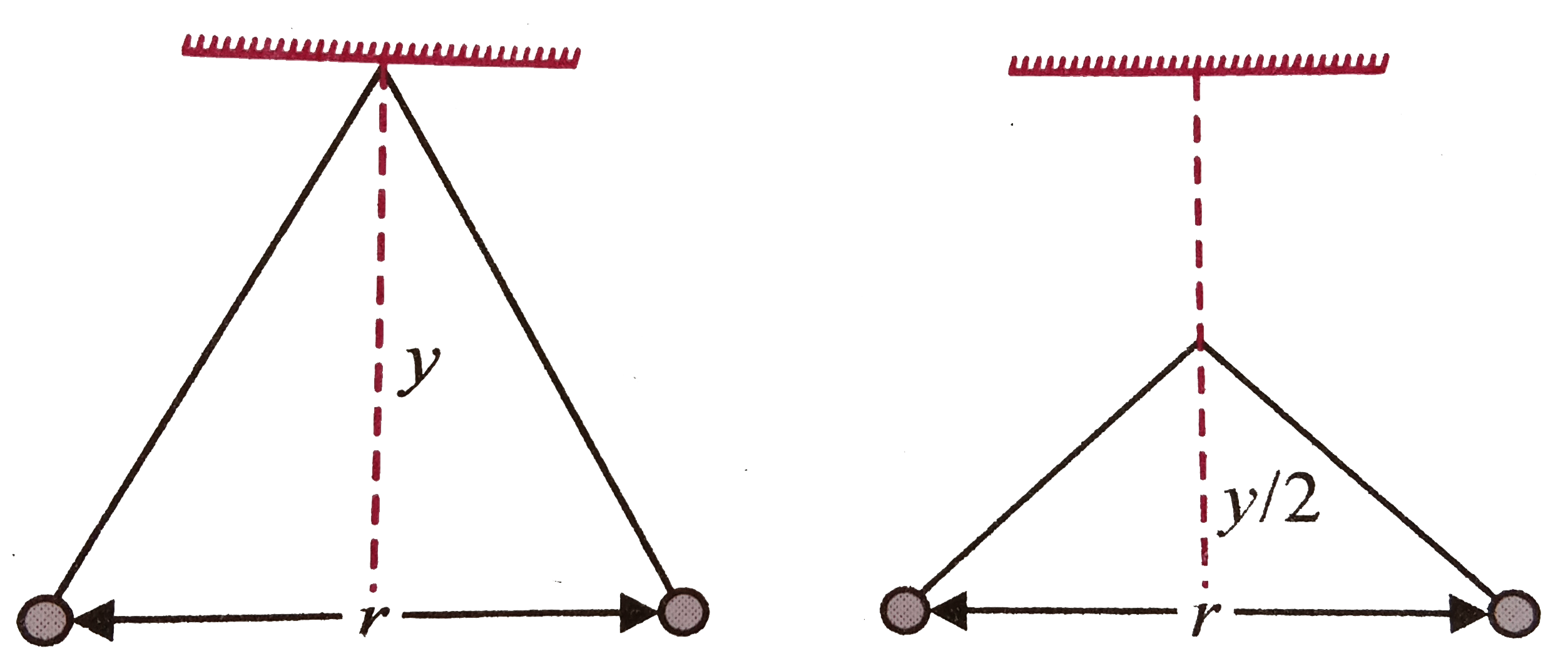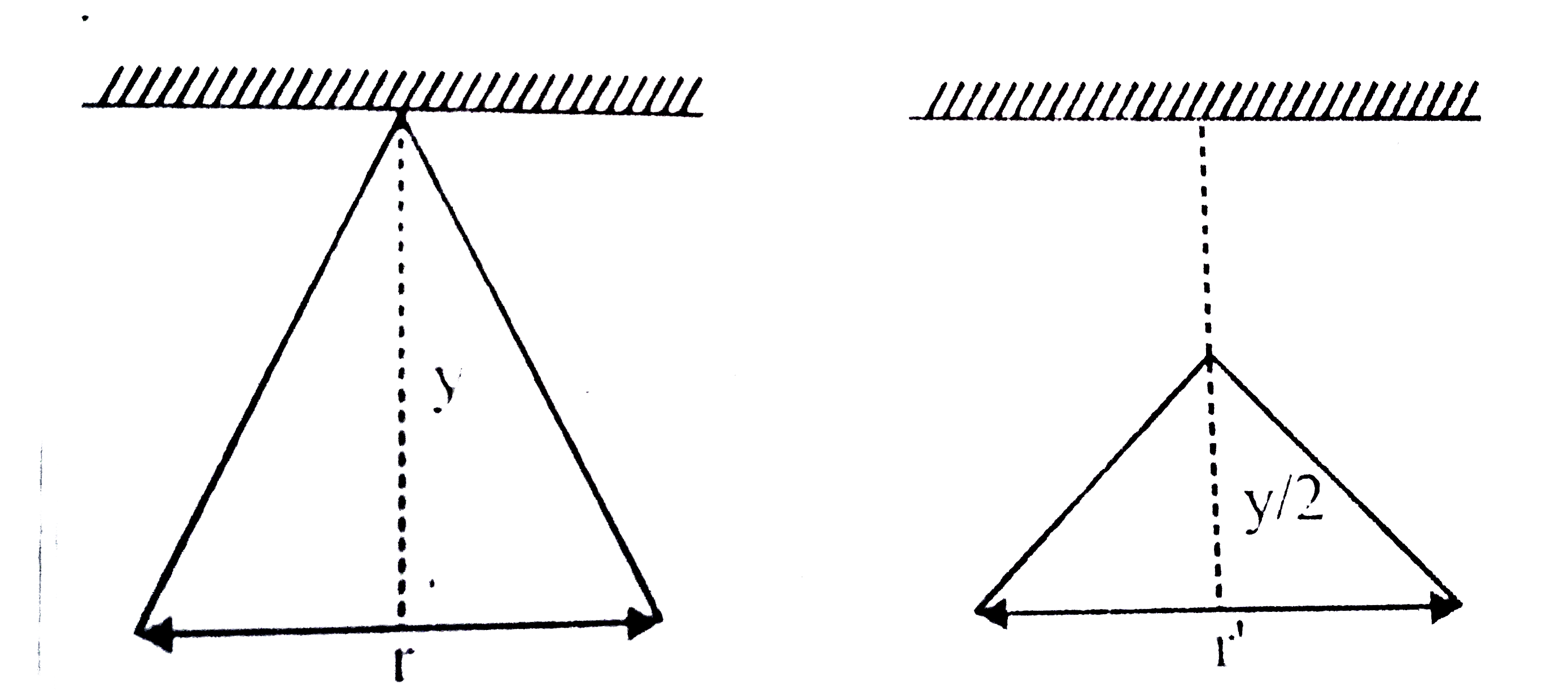Two indentical pith balls, each carrying charge q, are suspended from a common point by two strings of equal length l. Find the mass of each ball if the angle between the strings is 2θ in equilibrium.
To find the mass of each pith ball suspended at an angle of 2θ in equilibrium, we can follow these steps:
Step 1: Understand the Geometry
We have two identical pith balls, each carrying a charge q, suspended from a common point by strings of equal length l. The angle between the strings is 2θ. This means each string makes an angle θ with the vertical.
Step 2: Identify Forces Acting on the Balls
Each ball experiences three forces:
1. Tension T in the string.
2. Gravitational force mg acting downwards.
3. Electrostatic force Fe acting horizontally due to the repulsion between the two charges.
Step 3: Resolve the Tension
The tension T can be resolved into two components:
- Vertical component: Tcosθ=mg
- Horizontal component: Tsinθ=Fe
Step 4: Express Electrostatic Force
The electrostatic force Fe between the two charges q can be expressed using Coulomb's law:
Fe=kq2r2
where r is the distance between the two charges. In this case, since the angle between the strings is 2θ, the distance r can be expressed as:
r=2x
where x is the horizontal distance from the vertical line to each ball. Thus, we have:
Fe=kq2(2x)2=kq24x2
Step 5: Relate the Forces
From the vertical and horizontal components of the tension, we can set up the following equations:
1. Tcosθ=mg (1)
2. Tsinθ=Fe (2)
Step 6: Divide the Equations
Dividing equation (2) by equation (1):
TsinθTcosθ=Femg
This simplifies to:
tanθ=Femg
Step 7: Substitute for Electrostatic Force
Substituting the expression for Fe:
tanθ=kq24x2mg
Step 8: Express m
Rearranging gives:
m=kq24x2gtanθ
Step 9: Use Small Angle Approximation
For small angles, we can use the approximation tanθ≈sinθ≈θ. Thus:
m=kq2l4gx3
Final Expression for Mass
The mass of each ball can be expressed as:
m=kq2l4gx3
We have two identical pith balls, each carrying a charge q, suspended from a common point by strings of equal length l. The angle between the strings is 2θ. This means each string makes an angle θ with the vertical.
Each ball experiences three forces:
1. Tension T in the string.
2. Gravitational force mg acting downwards.
3. Electrostatic force Fe acting horizontally due to the repulsion between the two charges.
The tension T can be resolved into two components:
- Vertical component: Tcosθ=mg
- Horizontal component: Tsinθ=Fe
The electrostatic force Fe between the two charges q can be expressed using Coulomb's law:
Fe=kq2r2
where r is the distance between the two charges. In this case, since the angle between the strings is 2θ, the distance r can be expressed as:
r=2x
where x is the horizontal distance from the vertical line to each ball. Thus, we have:
Fe=kq2(2x)2=kq24x2
From the vertical and horizontal components of the tension, we can set up the following equations:
1. Tcosθ=mg (1)
2. Tsinθ=Fe (2)
Dividing equation (2) by equation (1):
TsinθTcosθ=Femg
This simplifies to:
tanθ=Femg
Substituting the expression for Fe:
tanθ=kq24x2mg
Rearranging gives:
m=kq24x2gtanθ
For small angles, we can use the approximation tanθ≈sinθ≈θ. Thus:
m=kq2l4gx3
The mass of each ball can be expressed as:
m=kq2l4gx3
Topper's Solved these Questions
- ELECTRIC FIELD AND POTENTIALBOOK - HC VERMACHAPTER - ELECTRIC FIELD AND POTENTIALEXERCISE - Objective 2
8 Videos
- ELECTRIC CURRENT THROUGH GASESBOOK - HC VERMACHAPTER - ELECTRIC CURRENT THROUGH GASESEXERCISE - Exercises
23 Videos
- ELECTROMAGNETIC INDUCTIONBOOK - HC VERMACHAPTER - ELECTROMAGNETIC INDUCTIONEXERCISE - EXERCISE
9 Videos
Similar Questions
Two idential pith balls , each of mass m and charge +q. are suspended from a point with threads of length l each. If in equiilbrium state θ be the angle which each thread makes with vertical in equilibrium , find value of charge on each ball.
View SolutionTwo identical balls each having a density ρ are suspended from as common point by two insulating strings of equal length. Both the balls have equal mass and charge. In equilibrium each string makes an angle θ with vertical. Now, both the balls are immersed in a liquid. As a result the angle θ does not change. The density of the liquid is σ. Find the dielectric constant of the liquid.
View Solution
Knowledge Check
Assertion : Two identical balls are charged by q. They are suspended from a common point by two insulating threads l each. In equilibrium, the angle between the tension in the threads is 180∘. (Ignore gravity).
Reason : In equilibrium tension in the spring is
T=14πε0q.ql2AIf both Assertion and Reason are correct and Reason is the correct explanation of AssertionBIf both Assertion and Reason are correct but Reason is not the correct explanation of AssertionCIf Assertion is true but Reason is falseDIf Assertion is false but Reason is trueTwo small balls, each having equal positive charge Q are suspended by two insulation strings of equal length l from a hook fixed to a stand. It mass of each ball =m and total angle between the two strings is 60∘m, then find the charge on each ball.
 A√mg4πε0l2B√2πε0l2mgC√πε0l2mg4D√4πε0l2mg√3
A√mg4πε0l2B√2πε0l2mgC√πε0l2mg4D√4πε0l2mg√3Two path balls carrying eqaul chareges are suspended froom a common point by strings of equal length, the strings are rightly clamped at half the height. The equilibrium separation between the balls, now becomes :
 A(2r3)B(1√2)2C(r3√2)D(2r√3)
A(2r3)B(1√2)2C(r3√2)D(2r√3)
Two identical spheres of mass m and charge q are suspended from a common point by two threads of the same length l and it is found that threads make an angle θ with the vertical when the spheres are in equilibrium . Calculate the value of q.
View SolutionTwo pitch balls carrying equal charges are suspended from a common point by strings of equal length, the equilibrium separation between them is r. Now the strings are rigidly clamped at half the height. The equilibrium separation between the balls now become

View SolutionTwo identical balls , each having a charge q and mass m , are suspended from a common point by two insultating strings each of length L. The balls are held at a separation x and then released. Find
(a) the electric force on each ball
(b) the component of the resultant force on a ball along and perpendicular to string
(c ) the tension in the string
(d) the acceleration of one of the balls. Consider the situation only for the instant just after the release.
View SolutionTwo identical ball having mass density ρ , mass m and charge q are suspended from a common point by two insulating massless strings of equal length. At equilibrium each string makes an angle theta with the vertical. Now both the balls are immersed in a fluid. At equilibrium, theta remains same. If the mass density of liquid is σ then dielectric constant of liquid will be
View SolutionTwo identical pith balls are charged by rubbing against each other. They are suspended from a horizontal rod through two strings of length 20 cm each, the separation between the suspension points being 5 cm. in equilibrium, the separation between the balls in 3 cm. Find the mass of each ball and the tension in the strings. the charge on each ball a magnitude 2.0×10−8C.
View Solution
